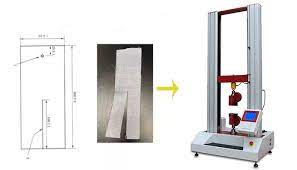- Qinsun Instruments Co., Ltd.
- Tell:+86-21-6780 0179
- Phone:+86-17740808215
- Address:No. 2578 Minhang District Gu Dai Road, Shanghai
- Contact:Mr. Li
- QQ:846490659
What are the devices used to test the fabric breaking strength?

Several devices are commonly used to test the breaking strength of fabrics, with each designed to meet specific testing standards and accommodate different types of fabrics. The choice of device depends on factors such as the type of fabric, testing standards, and the required level of precision. Here are some commonly used devices:
Universal Testing Machine (UTM):
- Description: A UTM is a versatile piece of equipment used for a wide range of materials testing, including textiles. It typically consists of a load frame, grips, and a system for applying a controlled force.
- Operation: Fabric specimens are clamped into grips, and a force is applied until the fabric breaks. The UTM measures the applied force, providing data on breaking strength.
- Description: Fabric breaking strength testers are specialized devices used to measure the breaking strength of fabric samples. These testers apply tension to the fabric until it breaks, allowing for the determination of the maximum force or load the fabric can withstand before failure. This information is crucial in assessing the fabric’s durability and performance in various applications.
Operation: To operate a fabric breaking strength tester, start by preparing fabric samples with standardized dimensions. Set up the tester according to the manufacturer's instructions, including calibrating if necessary. Mount the fabric sample securely between the grips and align it with the force direction. Set the desired test parameters, such as tension rate, on the control unit.
Elmendorf Tearing Tester:
- Description: This device is specifically designed to measure the tearing strength of fabrics. It's commonly used for lightweight and woven fabrics.
- Operation: A specimen is cut with a defined slit, and the force required to propagate the tear is measured. While not directly measuring breaking strength, tearing strength is related and relevant for certain applications.
Grab Test Instruments:
- Description: Grab test instruments are designed to perform grab tests, as specified in standards like ASTM D5034.
- Operation: Fabric specimens are clamped in the jaws of the instrument, and force is applied until the fabric breaks. These instruments are tailored to the requirements of grab test standards.
Strip Test Machines:
- Description: These machines are designed for strip tests, where a fabric strip is pulled until it breaks.
- Operation: Fabric strips are clamped in the machine, and force is applied until the fabric breaks. This type of testing is common for seatbelt materials and other applications where a narrow strip is more representative of the stress conditions.
Tensile Testers:
- Description: Tensile testers, similar to universal testing machines, are used for measuring the tensile properties of materials, including fabrics.
- Operation: Fabric specimens are clamped, and a tensile force is applied until the fabric breaks. Tensile testers are adaptable for various testing standards.
Ball Burst Testers:
- Description: This device is used to assess the resistance of fabrics to bursting forces. It's commonly employed for assessing the strength of upholstery fabrics.
- Operation: A fabric specimen is subjected to pressure from a spherical plunger until the fabric bursts. The burst strength is measured.
Shoe Sole Flexing Tester (for shoe fabrics):
- Description: This device is designed to evaluate the flexing resistance of shoe materials, including fabrics used in shoe construction.
- Operation: Fabric samples are subjected to repeated flexing motions to simulate wear and tear, and the breaking strength is assessed.
Fabric Strength Tester (Strip Method):
- Description: Specifically designed for testing the strength of fabrics using a strip method.
- Operation: Fabric strips are clamped and subjected to tension until they break, providing data on breaking strength.

It's important to note that the choice of the testing device should align with the specific standards and requirements relevant to the type of fabric being tested. Additionally, adherence to testing standards such as those established by ASTM or ISO ensures consistency and reliability in the results obtained.





